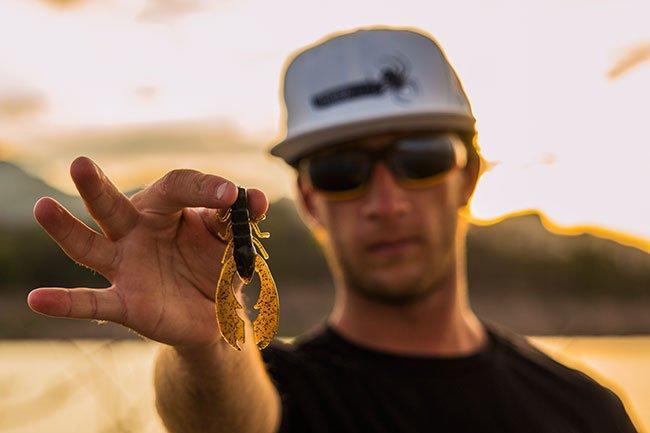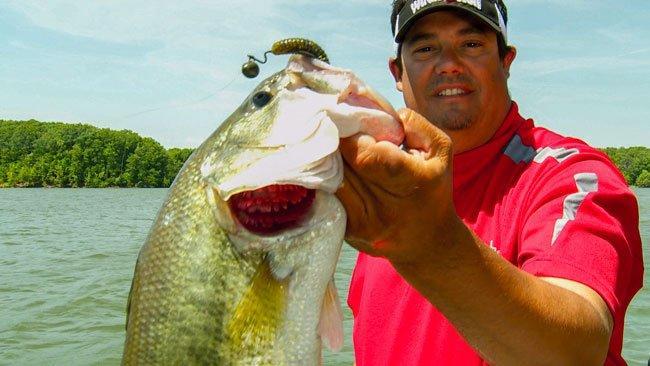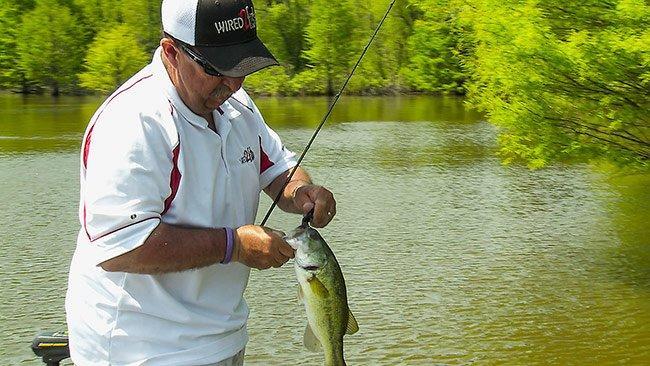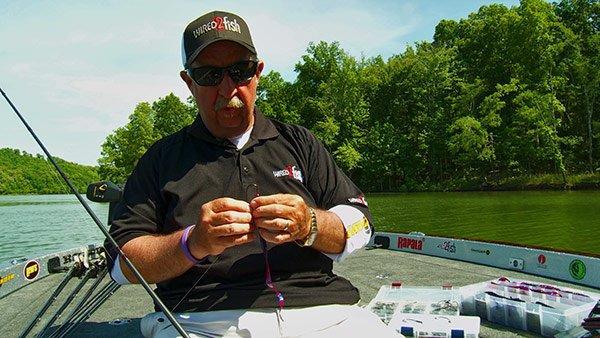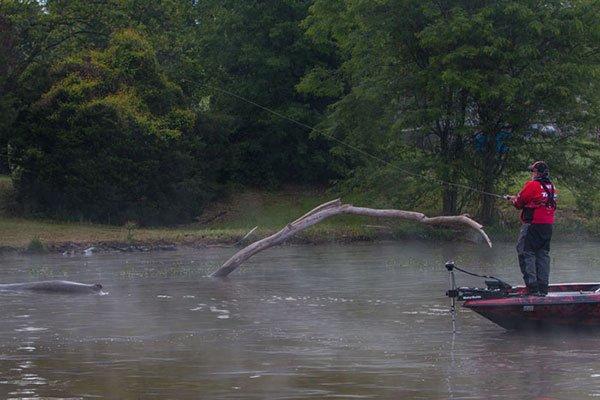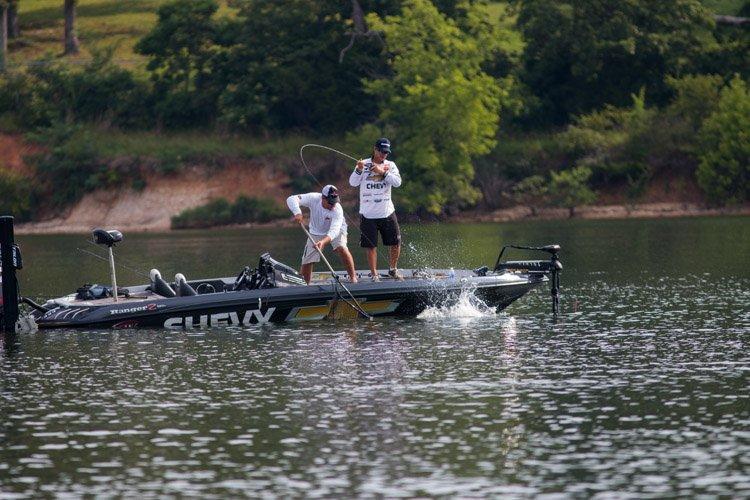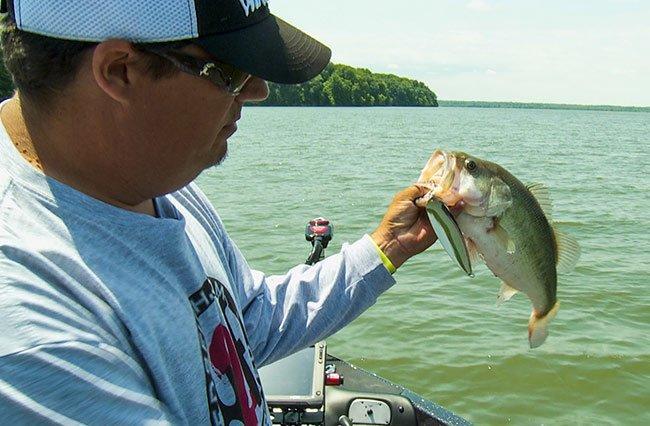Summer bass fishing can be frustrating for anglers of all skill levels. While increased boat traffic, kamikaze jet skis and lethargic bass behavior certainly makes for tough conditions, don’t trade your rods and reels for air conditioning just yet. There’s hope—and it comes in the form of standing timber.
Elite Series pro Fletcher Shryock has developed an intriguing, yet simple system for dissecting deep timber for summertime bass. According to him, these tips will increase both the quantity and quality of your catch.
Don’t fall into the trap
When you see lakes adorned with huge standing trees, it’s tempting to think each one plays host to a monster bass. This mindset, however, is often responsible for a lot of wasted time among anglers. Before you break out your favorite flipping rod and get carried away, make an effort to locate the high-percentage trees. Efficiently eliminating water is the biggest key to finding solid concentrations of fish relating to standing timber.
“Standing timber is an awesome place to find big bass, but don’t assume every tree holds a fish. It’s all about the location– the cover is secondary.”
“It’s not so much the timber that makes a spot special,” Shryock said. “It’s all about the location. I always look at the contours before I even think about fishing a specific section of trees. Throughout the summer, you want to find trees close to some sort of break line such as a point or a creek channel bend. If you get stubborn, you’ll be there for weeks trying to fish everything.”
So if everything looks the same, where do you even start? There are two primary characteristics Shryock looks for.
- Deep water nearby—”Your chances of catching a giant will skyrocket if you can find a section of trees with adjacent deep water,” Shryock said. “These break lines give bass two very important opportunities—they can easily slide up to feed in or around the trees and fall back into deeper water when they’re more lethargic. More often than not, they’re there for the depth change and the timber is just a welcomed bonus.”
- Change in timber patterns—”On many fisheries, a change in timber patterns can be indicative of a crucial depth change that’s prone to hold bass,” Shryock said. “Spend some time studying the depth, type and size of timber and you can develop a clear mental image of the bottom contour. When you get a good feel for it, you’ll be able to eliminate unproductive water at an astonishing rate.”
Get acclimated with a crankbait
Although you can definitely use a heavy jig or a big worm to get a feel for the bottom composition, branch layout or contour of standing timber, Shryock prefers a more efficient approach. It takes a bit of courage, but he swears by the results.
“If there’s a little stain to the water, I’m almost always going to start my dissection with a deep-diving crankbait,” Shryock said. “I know it can be a bit intimidating throwing an expensive lure around such gnarly cover, but if that crankbait dredges the bottom, I’m able to interpret any and all depth changes and available cover in just a few quick casts. When you’re slowly dragging something around, you’re wasting precious time.”
His approach isn’t as simple as chunking and winding, however. To avoid annoying hang-ups, he recommends the following.
- Invest in a plug knocker—”You can’t be afraid to lose your crankbait with this technique,” Shryock said. “You have to get down there and bang around to create reaction strikes, so snags are bound to happen. Keeping a simple plug knocker in the boat will save a bunch of your crankbaits and also give you more confidence to make tricky casts. You’ll be amazed how much better you can fish with a clear mind.”
- Use a steady retrieve—”A lot of people want to finesse their deep crankbaits through the timber,” Shryock said. “But I’ve found that reeling steadily throughout your retrieve will drastically reduce hang-ups. This keeps the lip pointing downward, which acts as a weed guard by protecting your treble hooks from the wood. Don’t get too carried away, of course, but just a moderate, steady retrieve will work wonders and save you a lot of hassle.”
Use worms and jigs for cleanup duty
Once Shryock feels something of interest with his crankbait or—even better—gets a few bites, he’ll slow down and use his one-two punch to fish the standing timber more thoroughly. His first choice is a Texas rigged 10-inch Berkley Power Worm on a 6/0 Lazer Trokar MagWorm B.A.R.B. EWG Hook, especially in the summer months.
“Not only do summertime bass love a big worm, but this setup also provides a very compact, manageable profile in heavy cover,” Shryock said. “A Carolina rig is too cumbersome for my liking around standing timber—the weight slides around and robs you of optimal feel and bottom contact. When fishing standing timber, compact presentations have a much straighter trajectory while falling, allowing me to easily target specific branches.”
What type of jig should I use?
Shryock prefers a large football jig when fishing standing timber. But if the branches are too thick, he’ll switch to the smaller profile of a casting or flipping jig to facilitate a straight, snag-free fall.
Before leaving an area, he also makes sure to make a few casts with a 3/4 or 1-ounce jig with a Berkley Powerbait Chigger Craw trailer. Again, efficiency is paramount when fishing standing timber and this heavy setup allows him to quickly reach the fish.
“A heavy jig gets to the bottom quickly and is an excellent imitation of crawfish and bluegill,” Shryock said. “I love stroking a big jig around standing timber because the bass will often suspend in the horizontal branches instead of the vertical trunk. “
For both big worms and jigs, Shryock strongly suggests employing these techniques.
- Yoyo your bait—”I always like to retrieve my bait over a limb instead of casting to it and letting it fall short,” Shryock said. “It allows you to move your bait more while keeping it in the strike zone longer. The bass won’t always eat it on the fall, so you’ll pick up some extra bites by keeping it in front of their noses.”
- Get up-close and personal—”Anytime the timber is above the water, I try to get pretty close to it,” Shryock said. “They’re going to be positioned within inches of the tree, so you want your bait to fall straight-down on top of them. If you make a long cast to standing timber, your bait will actually pendulum toward you as it falls, which takes it out of the strike zone.”
- Beware of dead weight—”When you’re yo-yoing your bait over a limb, pay close attention to any dead weight you might feel,” Shryock said. “That’s usually how the big ones bite. If it gets unusually heavy, keep a tight line and drop your rod tip a little. If you feel even the slightest movement or ‘tick’, set the hook!”
- Don’t horse ’em too much—”When you hang a big bass in standing timber, it’s all about keeping steady pressure on them,” Shryock said. “But if you feel like one has you wrapped up to the point you can’t feel it anymore, don’t pull any harder because you’ll break your line. Just keep moderate tension until the fish has been wrapped up for a minute or so. At this point, give it a foot or two of line and sometimes they’ll swim right out. Pulling harder doesn’t always get them unhung.”
Keep an open mind and be willing to adjust

I spent some time at Lake El Salto with Shryock and he cracked the code on one of the weirdest, funniest, yet most effective “patterns”—I guess you’d call it—I’ve ever seen. While the rest of us were dragging big worms around standing timber with very moderate success, he sacked a 34-pound limit before lunchtime. How, you might ask? He was swimming a big worm like a crankbait for suspended bass over 25 feet of water. I’m not even kidding.
Shryock’s gear for fishing standing timber
- Deep crankbait: 7-foot, 6-inch Abu Garcia Veritas 2.0 Winch | Abu Garcia REVO Winch Generation 3 | 12 to 17-pound Spiderwire Ultracast 100% Fluorocarbon
- Jig and Texas rig: 7-foot, 6-inch medium-heavy Abu Garcia Veracity | Abu Garcia REVO Rocket | 65-pound Spiderwire Ultracast Ultimate-Braid
He certainly didn’t set out to “swim the moccasin” as we jokingly called it, but his keen attention to detail and deliberate thought process evolved into the most effective big fish technique of the entire trip.
“Like everyone else, I was dragging a big worm over the tree limbs just like we’ve talked about in this article,” Shryock said. “I started to notice that every time I cranked my worm back to the boat, I’d get a big bite. The worm didn’t even have to touch the limbs, either. Those suspended bass were just purely reacting out of instinct, I guess. It didn’t make a bit of sense, but it just proves that keeping an open mind is indispensable. It’s hard to put your pride down and do things like that, but it can change your luck in a heartbeat.”
Don’t let the slow fishing action and unbearable heat get the best of you this summer. If you can find some standing timber near a depth change and dissect it efficiently, you’ll have an excellent chance of catching multiple big bass.




